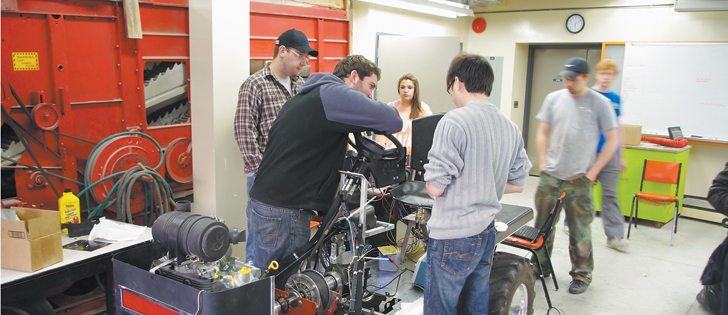University engineering | Students take their designs on the road to Illinois and take away skills in agricultural design
The University of Saskatchewan Sled Dogs finished sixth overall in total points at the recent International Quarter Scale Tractor Contest, while the University of Manitoba Tiny Tractors finished fourth in the pull category.
The competition, sanctioned by the American Society of Agricultural Biological Engineers, took place in Peoria, Illinois, May 31 to June 2 and included more than two dozen teams from university agricultural engineering departments across North America.
While the feature event is always the tractor pull, the intent of the competition is to prepare students for the real working world. So, as much fun as the tractor pull is, it’s only one factor in the overall scoring.
Read Also

India slaps 30 per cent import duty on yellow peas
India has imposed a 30 per cent duty on yellow pea imports with a bill of lading date on or after Nov. 1, 2025.
There are 18 other judged categories, including sportsmanship, craftsmanship, manufacturability, ergonomics, innovation, written design report and team presentation.
The U of M team finished 12th in total points. The University of Kentucky took top honours.
In the past, each team received a box-stock Briggs & Stratton 16 horsepower engine and a set of Titan rear drive tires. The engine could not be modified in any way. Beyond that, the rules were wide open to encourage innovation and original thinking.
Universities with big budgets ran five or six of the 16 h.p. engines in one tractor, which organizers felt gave them an unfair advantage.
The rules were changed this year so that each team was given a B&S 31 h.p. engine, two rear Titans and two smaller diameter front drive Titans. This meant that the tractors could simulate front wheel mechanical assist tractors, but true four-wheel drives are not allowed.
Teams that still had good 16 h.p. engines in their inventory were allowed two engines per tractor. These older tractors competed in their own class.
Third year engineering student Allison Graham said the judges are looking for innovative, original engineering along with practicality.
“It’s not all about tractor performance. There’s a marketing aspect to the competition as well,” she said.
Tractor designs must be marketable in a production run of 3,000 annually.
“We define our market and then design a tractor to fit that market.
“That means we’re judged on the thought process that goes into the tractor long before we even begin to design it. “
The same tractor can’t compete twice, which means teams must either scrap the previous tractor or make significant changes to the existing design. Some teams bring a fresh design every year while others keep a basic chassis up to three or four years.
The Sled Dogs entered two tractors this year: a modified version of its 2011 model with the 16 h.p. engine plus a new tractor with a fresh, ground-up design.
“For the last three years, our frame was quarter inch thick aluminum. The judges didn’t like that because of practicality, so the new tractor has a steel frame,” Graham said.
“Our new tractor is running the 31 h.p. big block with the CVT and transaxle from a John Deere Gator. That’s the same drive combination that worked pretty well in the 2011 tractor.”
The Sled Dog team has an annual budget of $40,000, much of which is needed for transportation and accommodation at the competition.
“We have 20 engineering students on the team and we have to raise all the money ourselves,” she said.
“We sell sponsorships on the tractor and local businesses donate things we need. That’s all part of the whole challenge. It’s like the real world.”
The University of Manitoba Association of Tiny Tractors came up with a design for 2012 that perplexed even the judges, according to team adviser Donald Petkau.
“I think a few of the judges were confused by the team’s design. It was quite unique.”
Because they were building a front wheel assist tractor, the r.p.m. at the smaller-diameter front tires had to make a perfect match with the r.p.m. of the larger-diameter rear tires.
They gutted the Argo amphibious transmission and had new gears custom cut in Michigan. Output from the 31 h.p. engine goes through a modified CVT snowmobile pulley transmission.
“But the students thought the primary clutch reacted too slowly for optimal Tractor Pull performance. So last year they removed the weights and built a manual control that the driver operated with a lever.
“That was a big improvement over the original primary clutch system.
“For 2012, they got really aggressive and attempted full electronic control of the primary clutch. They had a computer engineering student on the team for months trying to perfect it. They even built their own board and other components that weren’t available off the shelf.”
Petkau said the team finally had the electronic control system mating the engine data to the primary clutch control working quite well. The students were sure it was a winner until the day before they loaded the tractor on the trailer.
The board suddenly started grounding out and the electronic system that held so much promise was destroyed. Luckily, they still had all the parts for manual control, so they made it to Peoria on time, but Petkau said the tractor was not really a completed machine. However, it worked surprisingly well.
“They had two good runs, but then they had one bad run where they hit a soft spot and spun out early. If that hadn’t happened, they would have had first place.”
It might have been tempting for the team to stick with this year’s design, considering its fourth place finish in the pull competition.
However, Petkau said the team captain decided last week that the team is starting from scratch next year, which reflects the true spirit of the contest.
















